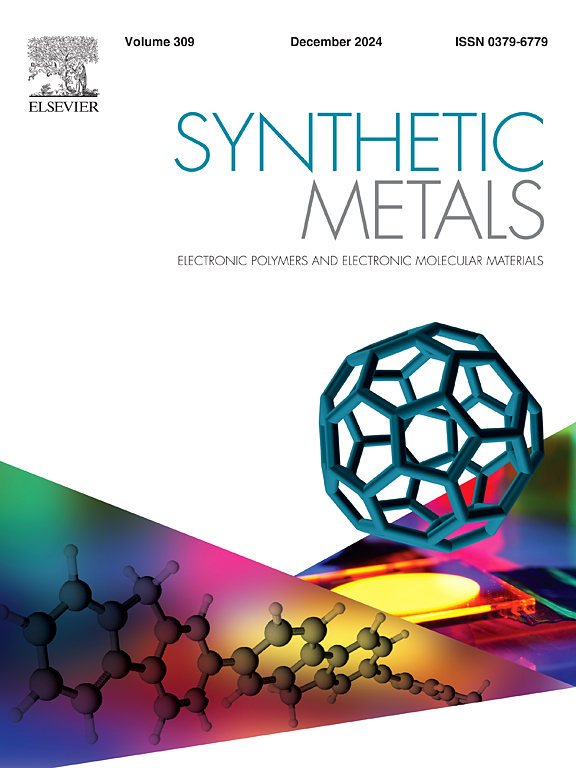ZnO-NF/石墨烯/Nafion作为一些药物活性成分传感器和储能应用的电极平台
IF 4.6
3区 材料科学
Q2 MATERIALS SCIENCE, MULTIDISCIPLINARY
引用次数: 0
摘要
本文介绍了一种同时检测扑热息痛(PAR)和布洛芬(IBU)的传感器。该传感器基于ZnO纳米花/石墨烯/Nafion涂层玻璃碳电极(ZnO NF/GR/Nafion/GCE)和具有相同电极组件的超级电容器电极。利用扫描电子显微镜(SEM)、x射线衍射光谱(xrd)、傅里叶变换红外光谱(FT-IR)和拉曼光谱(Raman)对制备的传感器和超级电容器电极进行了形貌表征。采用循环伏安法(CV)、差分脉冲伏安法(DPV)和电化学阻抗谱法(EIS)研究了ZnO NF/GR/Nafion传感器平台对IBU和PAR的电活性和选择性。在0.1 M B-R缓冲液(pH 4.0)的三电极电化学体系中对传感器进行电化学测试。ZnO NF/GR/Nafion传感器对PAR和IBU的线性范围分别为1.0和1000.0 μM。PAR和IBU的检出限分别为0.28 µM和0.31 µM。在实际样品分析中发现,该传感器在不同药物配方中对PAR和IBU均有较高的回收率(99.05 %和103.35 %)。通过改变相同的电极成分、成分的数量和比例,制备了超级电容器电极。在PVA-H2SO4电解液中,研究了该超级电容器电极在0 V ~ 1.2 V电位范围内的性能。超级电容器电极在扫描速率为5 mV s−1时的比电容为488.1 F g−1,在电流密度为7 mA.cm−2时的比电容为405.5 F g−1。在本研究中,制备的ZnO NF/GR/Nafion/GCE混合电极既用作传感器电极材料,又用作超级电容器电极材料,并在双模式下工作。该生产方法成本低廉,操作简单,在生产电极元件时不需要进行额外的修改。本研究首次将具有ZnO NF/GR/Nafion/GCE组分的电极材料用于某些药物活性成分的分析和超级电容器的应用。本文章由计算机程序翻译,如有差异,请以英文原文为准。
ZnO-NF/Graphene/Nafion as electrode platform for some pharmaceutical active ingredients sensor and energy storage applications
This paper presents a simultaneous sensor for the detection of paracetamol (PAR)and ibuprofen (IBU). The sensor is based on a ZnO nanoflower/Graphene/Nafion coated glassy carbon electrode (ZnO NF/GR/Nafion/GCE) and a supercapacitor electrode with the same electrode component. The morphological characterisation of the prepared sensor and supercapacitor electrode was conducted via scanning electron microscopy (SEM), structural characterisation by X-ray diffraction spectroscopy, chemical characterisation by Fourier transform infrared spectroscopy (FT-IR) and Raman analysis. The electroactivity and selectivity of the ZnO NF/GR/Nafion sensor platform towards IBU and PAR were simultaneously investigated by cyclic voltammetry (CV), differential pulse voltammetry (DPV) and electrochemical impedance spectroscopy (EIS). Electrochemical tests of the sensor were conducted in a three-electrode electrochemical system in 0.1 M B-R buffer (pH 4.0). The linear ranges of the ZnO NF/GR/Nafion sensor towards PAR and IBU were determined in the range of 1.0 and 1000.0 μM. The detection limits for PAR and IBU were calculated as 0.28 µM and 0.31 µM, respectively. In real sample analyses, the efficiency of the investigated sensor in different drug formulations was found to respond to PAR and IBU with high recovery (99.05 % and 103.35 %). The supercapacitor electrode was prepared by changing the same electrode component, amounts and ratios of the components. The performance of the supercapacitor electrode was investigated in the potential range from 0 V to 1.2 V in PVA-H2SO4 electrolyte. The supercapacitor electrode demonstrated a specific capacitance of 488.1 F g−1 at a scan rate of 5 mV s−1 and a capacitance value of 405.5 F g−1 at a current density of 7 mA.cm−2. In this study, the ZnO NF/GR/Nafion/GCE hybrid electrode produced is used as both sensor and supercapacitor electrode material and operates in dual mode. The production method is cheap and simple, and no additional modifications are needed in the production of electrode components. In this study, for the first time in the literature, the electrode material with ZnO NF/GR/Nafion/GCE component is used in the analysis of some pharmaceutical active ingredients and in supercapacitor applications.
求助全文
通过发布文献求助,成功后即可免费获取论文全文。
去求助
来源期刊

Synthetic Metals
工程技术-材料科学:综合
CiteScore
8.30
自引率
4.50%
发文量
189
审稿时长
33 days
期刊介绍:
This journal is an international medium for the rapid publication of original research papers, short communications and subject reviews dealing with research on and applications of electronic polymers and electronic molecular materials including novel carbon architectures. These functional materials have the properties of metals, semiconductors or magnets and are distinguishable from elemental and alloy/binary metals, semiconductors and magnets.
 求助内容:
求助内容: 应助结果提醒方式:
应助结果提醒方式:


